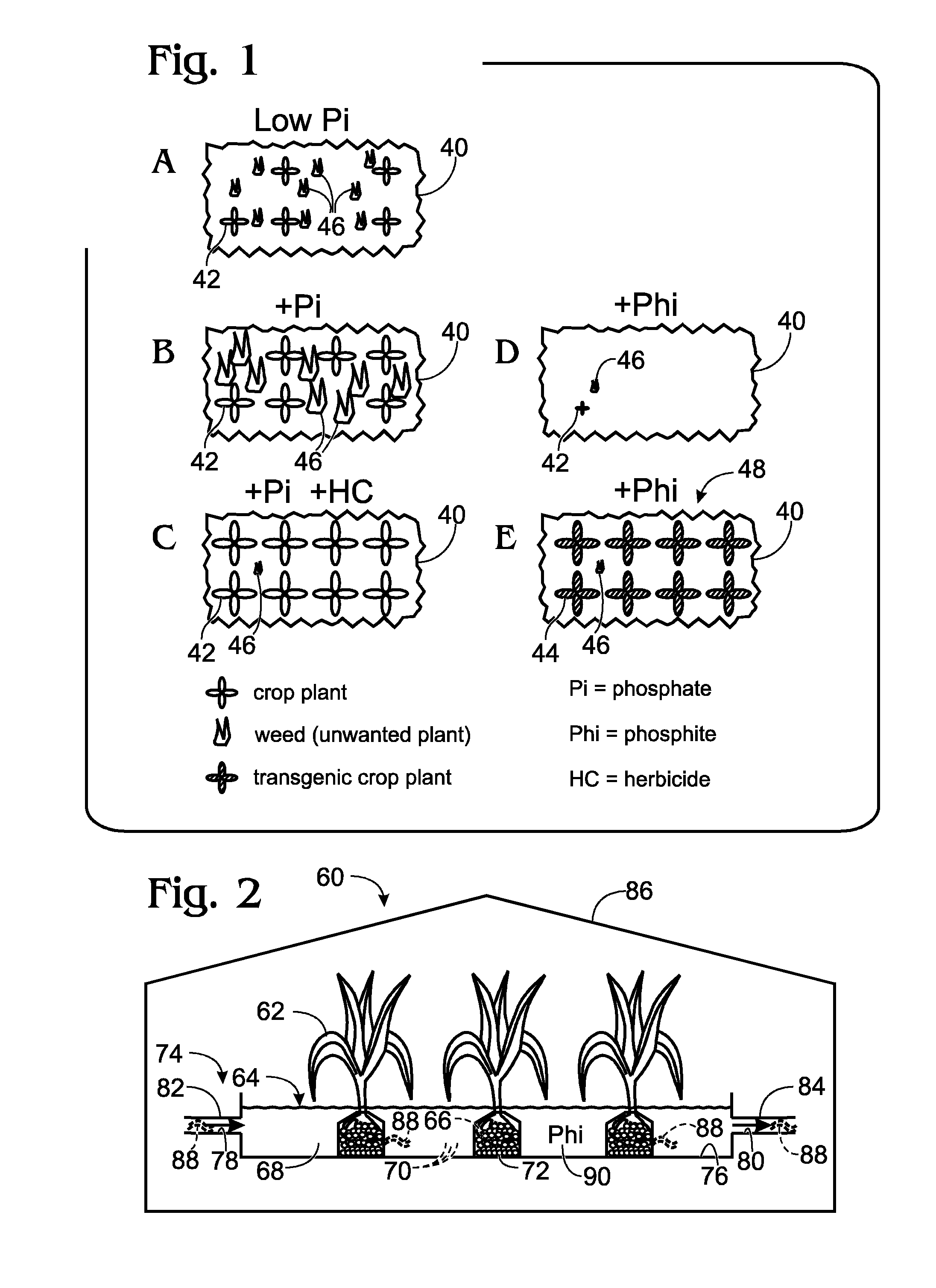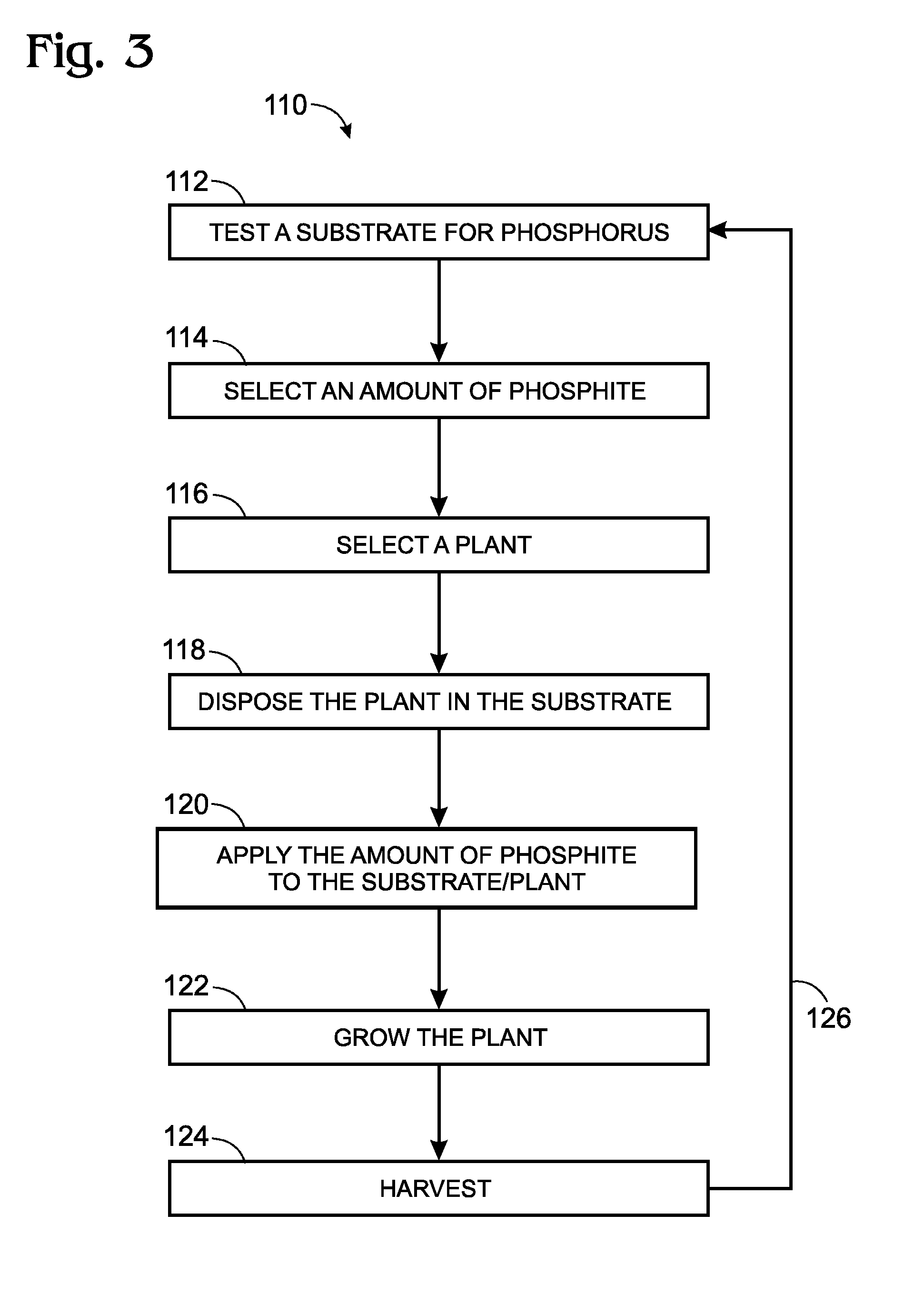Plant cultivation system utilizing phosphite as a nutrient and as a control agent for weeds and algae
- Summary
- Abstract
- Description
- Claims
- Application Information
AI Technical Summary
Benefits of technology
Problems solved by technology
Method used
Image
Examples
example 1
Experimental Results with Transgenic Plants and Weeds
[0080]This example describes experimental results with exemplary cultivation systems that utilize phosphite for fertilization and weed control; see FIGS. 4-14.
A. SUMMARY
[0081]Agriculture requires continuous input of orthophosphate (Pi)-based fertilizers and herbicides [1, 2]. However, since phosphorus (P) is a non-renewable resource and herbicides now face resistant weeds, these problems become two of the principal challenges for future agriculture [3-5]. A novel strategy is to engineer plants able to use alternative P sources not readily metabolized by microorganisms and weeds. Phosphite (Phi) has been proposed as a promising alternative P-fertilizer and as a non-selective herbicide [6, 7]. However its use has been hampered because Phi cannot be assimilated by plants [7]. Here, we report transgenic plants expressing a phosphite oxidoreductase [8] capable of completing their life cycle using Phi as a P source. Seed and biomass pro...
example 2
Experimental Results for Transgenic Tobacco in Agricultural Soil
[0167]This example describes exemplary experimental results obtained with a transgenic line of tobacco modified genetically to oxidize phosphite to phosphate and thereby use the phosphite as a phosphorus source, and a control (wild-type) line of tobacco, each cultivated in agricultural soil having a low phosphorus content, with no added phosphorus or with addition of phosphate or phosphite; see FIGS. 15-20.
[0168]The results of Example 1 were obtained from greenhouse experiments with plants grown in a sterilized mixture of sand and vermiculite as the substrate. In contrast, the present example reports experiments performed in a greenhouse using a non-sterilized agricultural soil as a substrate, to determine whether the cultivation system disclosed herein works equally well with a natural substrate. Although the experiments were performed in a greenhouse, the agricultural soil was not sterilized and therefore contained so...
example 3
Selected Embodiments
[0175]This example describes selected embodiments of the present disclosure as a series of numbered paragraphs.
[0176]1. A method of cultivating a transgenic plant that has been modified genetically to express an enzyme that catalyzes oxidation of phosphite to phosphate, the method comprising: (A) disposing the transgenic plant in a substrate having a content of available phosphate low enough to limit plant growth; and (B) applying an effective amount of phosphite to the substrate, and / or to foliage above the substrate, to enhance growth of the transgenic plant and to act as a weed-control agent that kills weeds and / or directly suppresses growth of weeds near the transgenic plant.
[0177]2. The method of paragraph 1, wherein the step of disposing the transgenic plant includes a step of disposing seeds, regenerative plant parts, and / or plantlets in and / or on the substrate, and wherein the seeds germinate, the plant parts regenerate, and / or the plantlets grow to produ...
PUM
| Property | Measurement | Unit |
|---|---|---|
| Fraction | aaaaa | aaaaa |
| Fraction | aaaaa | aaaaa |
| Molar density | aaaaa | aaaaa |
Abstract
Description
Claims
Application Information
 Login to View More
Login to View More - R&D
- Intellectual Property
- Life Sciences
- Materials
- Tech Scout
- Unparalleled Data Quality
- Higher Quality Content
- 60% Fewer Hallucinations
Browse by: Latest US Patents, China's latest patents, Technical Efficacy Thesaurus, Application Domain, Technology Topic, Popular Technical Reports.
© 2025 PatSnap. All rights reserved.Legal|Privacy policy|Modern Slavery Act Transparency Statement|Sitemap|About US| Contact US: help@patsnap.com



